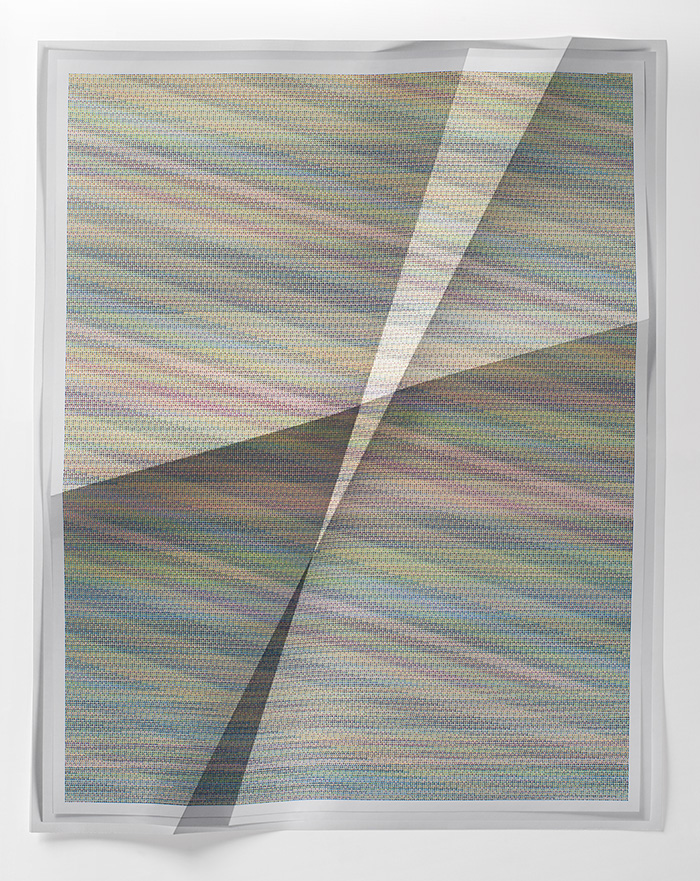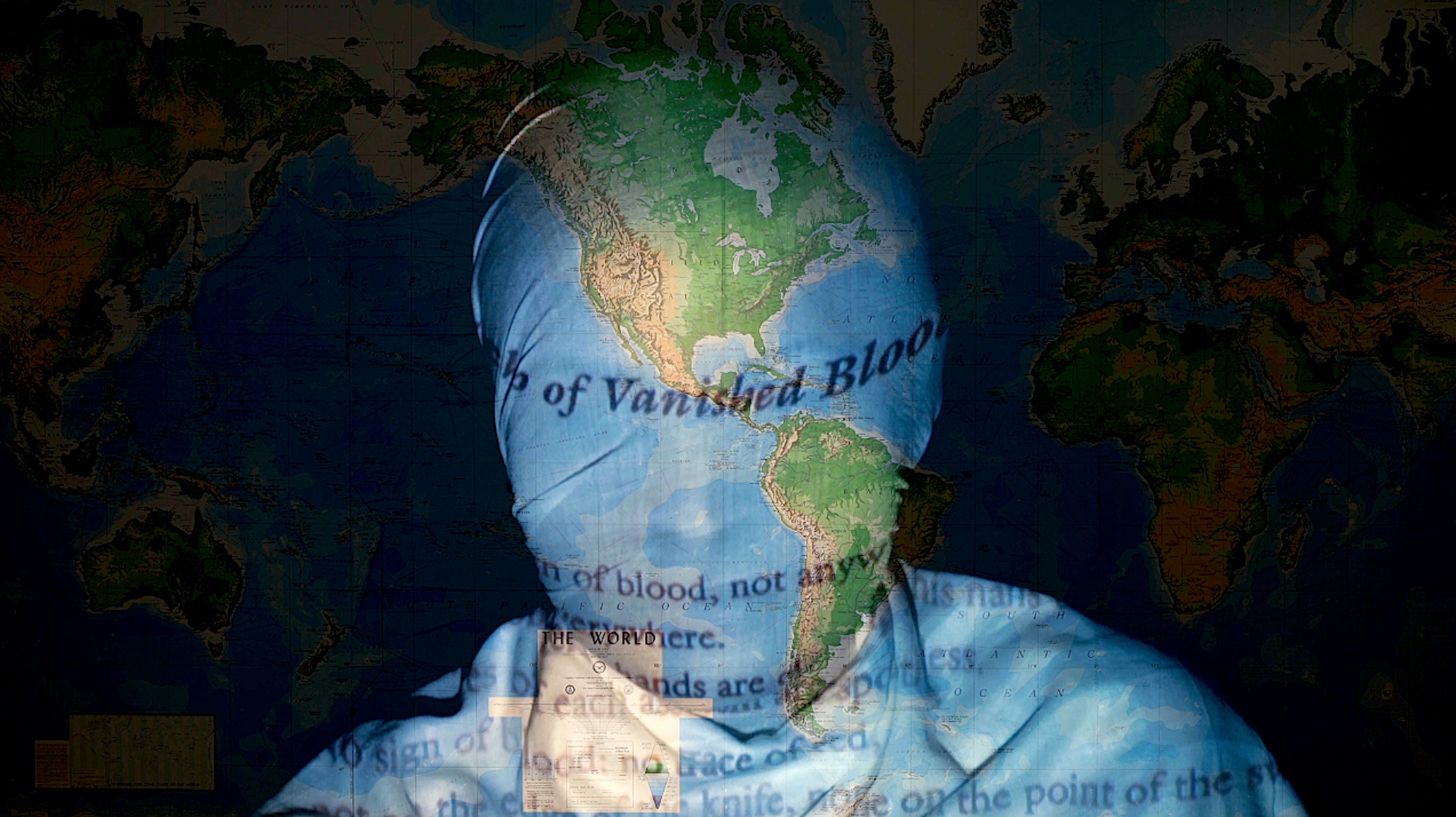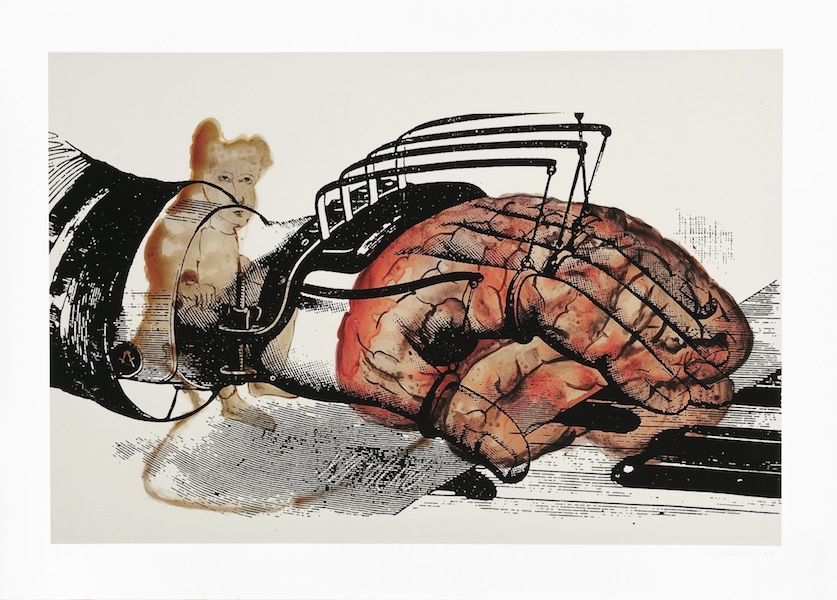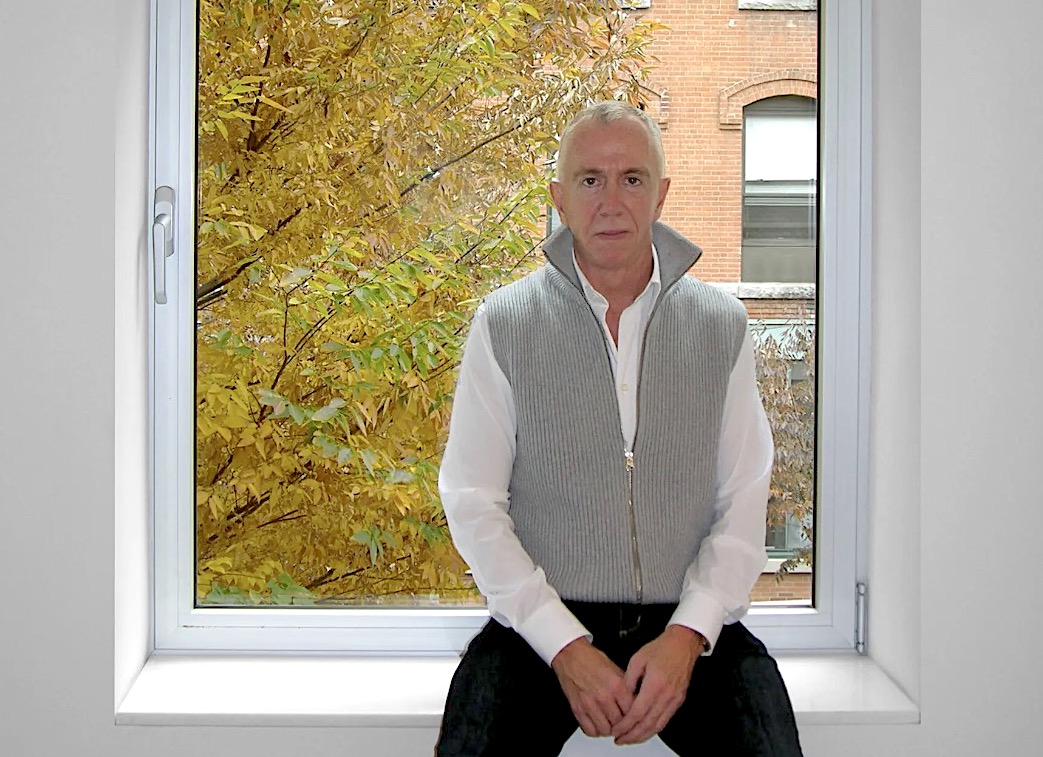
© » KADIST
Jennifer Locke
Choke documents the artist filming a wrestler “choking out” his teammate until he is unconscious. This closed circuit of dominance and submission between two powerful men, is echoed by the closed circuit of the video through which the viewer takes on the role of voyeur. The artist’s presence in the piece not only calls attention to its staging, but inverts the traditional power dynamic of the “male gaze” and gender roles.

© » KADIST
Yang Guangnan
In Action no. 1 Yang Guangnan reflects on the interiority and exteriority of human-technological experience with mechanical gestures that are semi-human and semi-machine. A hanged shirt mounted upon the artist’s machine rhythmically bounces and rotates in a way that suggests a skeletal interior.

© » KADIST
Milena Bonilla
Drawing & Print (Drawing & Print)
Milena Bonilla’s discursive practice explores connections among economics, territory, and politics through everyday interventions. Her drawings, sculptures, and photography are active investigations into our often-fallible notions of history. Stone Deaf (2009) is a direct intervention into Karl Marx’s gravesite, for which the artist literally traced the history of Marx’s grave.

© » KADIST
Wang Taocheng
Reflection Paper No. 2 is one of four videos in which Wang attempts to accurately illustrate the writings of influential Chinese Eileen Chang, who published her works during the Japanese occupation of China. Image and text reflect on the everyday experiences of women in society, family, marriage, love, and death.

© » KADIST
Yang Guangnan
Itch explores the relationship between technology and daily human experience with a motorized arm that extends from within the gallery’s wall, moving up and down while holding a projector that shows a desperately scratching pair of hands.

© » KADIST
Jeffry Mitchell
Poised with tool in hand, Jeffry Mitchell’s The Carpenter (2012) reaches forward, toward his workbench. It is difficult to tell whether the work represents just any carpenter or Christ, the most famous member of the profession and the subject of innumerable parables and artworks. His stilted pose is not too Messianic; drips of ochre glaze render his handiwork and hammer equally soft.

© » KADIST
Jeffry Mitchell
In Man and Pet (2012), two benign ceramic figures smile sweetly upward. The man wraps his small companion in a hug, his arms extending in round arcs all the way to his feet. Though the expressions are strikingly similar—suggestive of Rockwellian Americana—the pet seems somewhat more genial and familiarly fuzzy than its owner, whose saurian pupils lend his face a reptilian air that belies his warm grin.

© » KADIST
Jeffry Mitchell
Though the title might suggest an Adonis, Jeffry Mitchell’s The Swimmer (2012) is a squat, jolly man with a protuberant belly. The stocky figure lets his arm drop to his side, towel dripping on the ground. Mitchell’s umber-toned glaze makes everything look earthy and wet, primordial and warm.

© » KADIST
Bjorn Copeland
Sign #1 , Sign #2 , Sign #3 were included in “Found Object Assembly”, Copeland’s 2009 solo show at Jack Hanley Gallery, San Francisco. These rather austere collages were created by simply cutting and inverting the text from existing information signs. In Sign #2 , for example, the original image that presumably carried the message “NO RIDERS” was placed upside down.

© » KADIST
Leslie Shows
Human Quarry is a large work on paper by Leslie Shows made of a combination of acrylic paint and collage. Both through its title and formally—through how the shapes in the composition resemble a mountain or natural formation—the piece relays us to a mineral quarry or a deep mining pit where materials are extracted. Interspersed among the block-like figures and rocky textures, we also see several human silhouettes, either cut-out, or as if they were whited out by a shining light, or lost in the shadows.

© » KADIST
Clare Rojas
Rojas’s two pieces in the Kadist Collection— Untitled (four-legged…) and Untitled (Bird’s Eyes) —are representative of her pictorial style which uses bold colorful blocks of paint and female and animal characters. While Untitled (Bird’s Eyes) does not depict any actual women, it nevertheless alludes to gender roles and the power of the female gaze. Apparently playful, this scene of two animals has an ominous quality: A bird and a hedgehog confront at each other and the bird appears to be poking, even eating the hedgehog’s eye.

© » KADIST
Matt Lipps
In the series Horizons (2010), Lipps uses appropriation to riff on Modernism’s fascination with abstract form. For Untitled (Men) (2011), he snipped from magazines and textbooks pictures of handsome or famous men, from the ancient Greek to the modern. Arranged in a tableau, lit theatrically, and rephotographed, the two-dimensional figures have an embodied presence.

© » KADIST
John Houck
Houck’s Peg and John was made as part of a series of photographic works that capture objects from the artist’s childhood. In this image, drafting materials (pencils, compasses, and protractors) are laid out next to shotgun shell casings. Presenting these objects in juxtaposition but without commentary, Houck offers a partial but interesting glimpse into his own biography.

© » KADIST
Shahzia Sikander
The Last Post was inspired by Sikander’s ongoing interest in the colonial history of the sub-continent and the British opium trade with China. In this animation, layers of images, abstract forms, meaning, and metaphorical associations slowly unfold at the same time that more visual myths are created. The identity of the protagonist, a red-coated official, is indeterminate and suggestive of both the mercantilist policies that led to the Opium Wars with China and the cultural authority claimed by the Company school of painting over colonial India.

© » KADIST
John Houck
Untitled #242 is part of Houck’s Aggregates Series, which uses digital tools to manipulate chosen sets and pairs of colors, creating colorful index sheets, bathed in colors and lines. Houck transforms these simple outputs physically, folding, lighting, photographing, and re-printing them, only to fold, photograph, and re-print again. An MFA graduate from UCLA, John Houck works primarily in the medium of photography and specializes in still-life vignettes.

© » KADIST
Geoffrey Farmer
Ongoing Time Stabbed with a Dagger was Farmer’s first kinetic sculpture that added a cinematic character to an “ever-reconfiguring play presented in real time.” The assembly of various objects and props on top of a large platform constitutes not only a work, but, to a certain extent, a show in itself. The title of the piece comes from the literal translation of René Magritte’s painting from 1938, La Durée Poignardée , whose more familiar translation is “Time Transfixed.”

© » KADIST
Nalini Malani
Malani draws upon her personal experience of the violent legacy of colonialism and de-colonization in India in this personal narrative that was shown as a colossal six channel video installation at dOCUMENTA (13), but is here adapted to single channel. The video is largely silent until violent crashes and female voices overwhelm the viewer, portraying the inner voice of a woman who is brutally gang raped. Malani addresses the fatal place of women in Indian society and the geo-politics of national identity.

© » KADIST
Julieta Aranda
The video Swimming in rivers of Glue is composed of various images of nature, exploring the themes of exploration of space and its colonization. The images show the diversity of forms of life on earth. These forms are associated with texts that relay a form of propaganda.

© » KADIST
Clare Rojas
Rojas’s two pieces in the Kadist Collection— Untitled (four-legged…) and Untitled (Bird’s Eyes) —are representative of her pictorial style which uses bold colorful blocks of paint and female and animal characters. While Untitled (Bird’s Eyes) does not depict any actual women, it nevertheless alludes to gender roles and the power of the female gaze. Apparently playful, this scene of two animals has an ominous quality: A bird and a hedgehog confront at each other and the bird appears to be poking, even eating the hedgehog’s eye.

© » KADIST
Yang Xinguang
Although seemingly unadorned at first glance, Yang Xinguang’s sculptural work Phenomena (2009) employs minimalist aesthetics as a means of gesturing towards the various commonalities and conflicts between civilization and the natural world. Comprised of rudimentary planks of wood hammered together into a rectangular form, Yang’s work uses reclaimed materials from everyday life and seems deliberately in conversation with Arte Povera, the art movement that originated in Italy during the late 1960s where practitioners produced art from found and common materials as an act of resistance against the decided commercialization of the art world through market economies. Yang, by extension, pays close attention to his materials in attempt to release the forms within them rather than impose his own.

© » KADIST
John Houck
Baby Shoes, Never Worn is part of photographer John Houck’s series of restrained still-life photographs capturing objects from his childhood. The image depicts a box, addressed to the artist’s mother, that once contained—it can be assumed—baby shoes. Houck layers the photograph with multiple exposures, lending an uneasy tripling effect to the static object.

© » KADIST
John Houck
John Houck’s brown- , sienna- and golden-toned composition, Untitled #185, 65, 535 combinations of a 2×2 grid, 16 colors , features densely packed lines of color moving diagonally across the creased page. Houck uses a series of self-designed software programs to create these intricate grids of color and line, riffing off of Sol LeWitt, perhaps, in a digital age. Houck takes the output of these programs and then manipulates them manually, creasing the pages of the index print, and then re-photographing them.

© » KADIST
Nalini Malani
Memory: Record/Erase is a stop-motion animation by Nalini Malani based on ‘The Job,’ a short story by celebrated German poet and playwright Bertolt Brecht. Brecht’s story follows a poverty-stricken family during the German depression, as the central character, Frau Hausmann, is forced to impersonate her late husband to procure his job as a nightwatchman to support her two children. Despite her exceptional performance during the job, and even after receiving public commendation for catching a thief, when eventually her identity is discovered during a factory accident she is forced into a precarious existence where she resorts to selling herself to get by.

© » KADIST
Matt Lipps
Untitled (Women) (2011) presents a startlingly succinct history of violently romanticized femininity. Matt Lipps created this diptych by photographing a single arrangement of cutouts. As in his analogous portrait of men, the middle section appears twice, on either side of the split, signaling a stutter, a caesura, or a schizophrenic break.

© » KADIST
John Houck
John Houck’s multi-layered photographic compositions immortalize nostalgic objects from the artist’s childhood, manipulated in the studio and in post-production into unreal still-life arrangements. Stamp -X, Stamp -Y consists of a careful collage of uneven scraps of paper. On their versos, these fragments of blue, white, and manila papers hold the artist’s childhood stamp collection; turned as they are, these shards of envelope become planes of colors that Houck manipulates in a vaguely grid-like fashion.

© » KADIST
Kara Walker
In her masterpiece 8 Possible Beginnings or The Creation of African-America , Walker unravels just that, the story of struggle, oppression, escape and the complexities of power dynamics in the history following slave trade in America. Her use of contour and silhouette accentuate emotion with rigor, she reduces the narrative to black and white as gruesome acts of sex and violence address trauma, fear and suffering through a majestic play of shadow and light.

© » KADIST
Tony Oursler
Continuing Oursler’s broader exploration of the moving image, Absentia is one of three micro-scale installations that incorporate small objects and tiny video projections within a miniature active proscenium. Mounted on platforms suspended in space on metal stands, the video sculpture contemplates human relationships, expressed here by shouts and murmurs, the strange and the familiar.
John Houck
- year born: 1977
- gender: male
- nationality: American
- home town: South Dakota
Jeffry Mitchell
The Seattle-based sculptor Jeffry Mitchell creates cartoonlike creatures from low-fire earthenware...
Nalini Malani
- year born: 1946
- gender: female
- nationality: Indian
- home town: Karachi, Pakistan
Clare Rojas
- location: San Francisco, California
- year born: 1976
- gender: female
- nationality: American
- home town: Columbus, Ohio
Matt Lipps
- location: San Francisco, California
- year born: 1975
- gender: male
- nationality: American
- home town: San Francisco, California
Milena Bonilla
Milena Bonilla’s discursive practice explores connections among economics, territory, transit, and politics through everyday interventions...
Yang Guangnan
- location: New York City, United States
- year born: 1986
- home town: Inner Mongolia, China
Kara Walker
- location: New York, New York
- year born: 1969
- gender: female
- nationality: American
- home town: Stockton, California
Tacita Dean
- location: Berlin, Germany
- year born: 1965
- gender: female
- nationality: British
- home town: Canterbury, United Kingdom
Julieta Aranda
- location: Mexico City, Mexico
- year born: 1975
- gender: female
- nationality: Mexican
- home town: Mexico City, Mexico
Geoffrey Farmer
- location: Vancouver, British Columbia
- year born: 1967
- gender: male
- nationality: Canadian
- home town: Eagle Island, Canada
Jennifer Locke
Working in video and installation-based performance, Jennifer Locke stages physically intense actions in relation to the camera and specific architecture in order to explore the unstable nature of artist/model/camera/audience hierarchies...
Wang Taocheng
Wang Taocheng is a Shanghai artist who lives and works in Amsterdam...
Tony Oursler
- year born: 1957
- gender: male
- nationality: American
- home town: New York, New York
Yang Xinguang
- location: Beijing, China
- year born: 1980
- gender: male
- nationality: Chinese
- home town: Hunan Province, China
Leslie Shows
- location: San Francisco, California
- year born: 1977
- gender: female
- nationality: American
Bjorn Copeland
- location: New York, New York
- gender: male
Nathan Mabry
- location: Los Angeles, California
- year born: 1978
- gender: male
- nationality: American
- home town: Durango, Colorado
Shahzia Sikander
- location: New York
- location: Texas
- year born: 1969
- gender: female
- nationality: Pakistani-American
- home town: Lahore, Pakistan

© » ARTLYST
about 3 months ago (01/17/2024)
Brent Sikkema, the Manhattan art dealer renowned for representing artists such as Jeffrey Gibson and Kara Walker found dead The post Brent Sikkema – Visionary Art Dealer Of Jeffrey Gibson And Kara Walker Murdered appeared first on Artlyst ....
-
1990-1999
Nalini Malani
1996Memory: Record/Erase is a stop-motion animation by Nalini Malani based on ‘The Job,’ a short story by celebrated German poet and playwright Bertolt Brecht...
-
2000-2009
Tacita Dean
2001The photographic quality of the film Baobab is not only the result of a highly sophisticated use of black and white and light, but also of the way in which each tree is characterized as an individual, creating in the end a series of portraits...
Jennifer Locke
2005Choke documents the artist filming a wrestler “choking out” his teammate until he is unconscious...
Kara Walker
2005In her masterpiece 8 Possible Beginnings or The Creation of African-America , Walker unravels just that, the story of struggle, oppression, escape and the complexities of power dynamics in the history following slave trade in America...
Clare Rojas
2006Rojas’s two pieces in the Kadist Collection— Untitled (four-legged…) and Untitled (Bird’s Eyes) —are representative of her pictorial style which uses bold colorful blocks of paint and female and animal characters...
Clare Rojas
2008Rojas’s two pieces in the Kadist Collection— Untitled (four-legged…) and Untitled (Bird’s Eyes) —are representative of her pictorial style which uses bold colorful blocks of paint and female and animal characters...
Milena Bonilla
Drawing & Print
2009(Drawing & Print) Milena Bonilla’s discursive practice explores connections among economics, territory, and politics through everyday interventions...
Bjorn Copeland
2009Sign #1 , Sign #2 , Sign #3 were included in “Found Object Assembly”, Copeland’s 2009 solo show at Jack Hanley Gallery, San Francisco...
Geoffrey Farmer
2009Ongoing Time Stabbed with a Dagger was Farmer’s first kinetic sculpture that added a cinematic character to an “ever-reconfiguring play presented in real time.” The assembly of various objects and props on top of a large platform constitutes not only a work, but, to a certain extent, a show in itself...
Yang Xinguang
2009Although seemingly unadorned at first glance, Yang Xinguang’s sculptural work Phenomena (2009) employs minimalist aesthetics as a means of gesturing towards the various commonalities and conflicts between civilization and the natural world...
-
2010-2019
Shahzia Sikander
2010The Last Post was inspired by Sikander’s ongoing interest in the colonial history of the sub-continent and the British opium trade with China...
Yang Guangnan
2011Itch explores the relationship between technology and daily human experience with a motorized arm that extends from within the gallery’s wall, moving up and down while holding a projector that shows a desperately scratching pair of hands....
Matt Lipps
2011In the series Horizons (2010), Lipps uses appropriation to riff on Modernism’s fascination with abstract form...
Matt Lipps
2011Untitled (Women) (2011) presents a startlingly succinct history of violently romanticized femininity...
Jeffry Mitchell
2012Poised with tool in hand, Jeffry Mitchell’s The Carpenter (2012) reaches forward, toward his workbench...
Jeffry Mitchell
2012Though the title might suggest an Adonis, Jeffry Mitchell’s The Swimmer (2012) is a squat, jolly man with a protuberant belly...
Nalini Malani
2012Malani draws upon her personal experience of the violent legacy of colonialism and de-colonization in India in this personal narrative that was shown as a colossal six channel video installation at dOCUMENTA (13), but is here adapted to single channel...
Tony Oursler
2012Continuing Oursler’s broader exploration of the moving image, Absentia is one of three micro-scale installations that incorporate small objects and tiny video projections within a miniature active proscenium...
John Houck
2013Houck’s Peg and John was made as part of a series of photographic works that capture objects from the artist’s childhood...
John Houck
2013Untitled #242 is part of Houck’s Aggregates Series, which uses digital tools to manipulate chosen sets and pairs of colors, creating colorful index sheets, bathed in colors and lines...
John Houck
2013Baby Shoes, Never Worn is part of photographer John Houck’s series of restrained still-life photographs capturing objects from his childhood...
John Houck
2013John Houck’s brown- , sienna- and golden-toned composition, Untitled #185, 65, 535 combinations of a 2×2 grid, 16 colors , features densely packed lines of color moving diagonally across the creased page...
John Houck
2013John Houck’s multi-layered photographic compositions immortalize nostalgic objects from the artist’s childhood, manipulated in the studio and in post-production into unreal still-life arrangements...
Julieta Aranda
2016The video Swimming in rivers of Glue is composed of various images of nature, exploring the themes of exploration of space and its colonization...



